Uncle Henry Next Generation Bowie Review
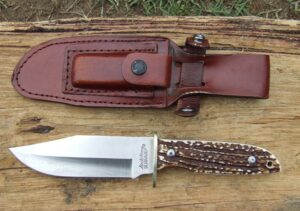
I love the look of the bowie knife design, so when I saw the Uncle Henry Next Generation Bowie for sale, I was quick to order it. Even though it wasn’t a large Bowie, I was hoping it would work well for camping, processing game and field use.
In this Uncle Henry Next Generation Bowie review, I will break the article up into two sections. The first is part is the initial impressions and specifications of the Bowie. The second part is the field test and review.
I have owned the Uncle Henry Next Generation Bowie for over 14 months or so. I haven’t used it solely as a primary knife when camping, but enough use to give the knife a fair test and review over that time.
The Uncle Henry Next Generation Bowie is a fixed blade, full tang knife. The length of the blade is 5 inches.
To check out the top bushcraft knives, click on – Best Bushcraft Knives For Under $100.
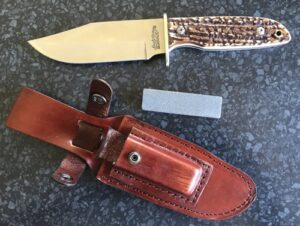
The knife is made by Schrade.
I did notice on some other knife websites and on the packaging of the knife, it was called the – Uncle Henry Large Pro Hunter. Which depending on the sites you go to, there are a few different names for it. I think the marketing department mucked up by calling it “large,” as a large Bowie would be a lot longer.
Anyhow, for the review I will call it the Uncle Henry Next Generation Bowie, as that seemed to be the most common name for it.
(Maybe for different countries they label it differently, or perhaps the marketing material has been mixed up. As the Uncle Henry and Schrade range has hundreds of knifes and some names cover a few different types of knifes. The knife is sometimes labelled from being manufactured at Schrade.)
I remember the small two blade pocket knife with bone or antler handle from the old Schrade pocket knives that had a great reputation. So I was hoping the Uncle Henry Bowie would take me down memory lane and not disappoint me for the knife review.
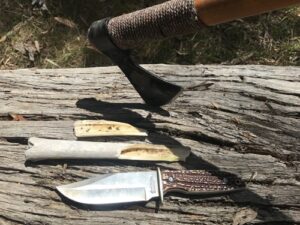
Initial first impressions out of the box. (I should say blister pack.)
The knife felt solid and the handle fitted my hands okay. I would say I have maybe medium size hands, but if you have large hands, the handle might be too small.
The handle tapers off towards the butt end, so that’s why it probably feels a bit small.
On first look at the Next Gen Staglon scales on the handle, they looked good. Then the second glance at them and I would just think okay and a bit fake. Obviously not as nice as real antler, but okay.
The artificial antler or bone scales and handles have come a long way since the old fake looking versions, but still could be improved.
The sides of the scale were a bit too white and the shiny white looked too artificial. However, I know after a few days in the field and they would tone down the shine and look more natural.
The scales on the right side of one section had a rough edge about an inch long. (2.5cm) I assume if you were doing a lot of knife work it would rub. I will see how it handles (No pun intended. Wish I had of thought of it though first) before I take some fine sandpaper or emery cloth to the rough part.
I tested how sharp the blade was on my forearm hairs and it shaved them out of the box. (Not recommended for safety.) It did take a bit of effort to shave the forearm hairs off, but not too bad.
The gold guard gave it a nice touch and polished look made it look distinctive.
The leather sheath felt solid, a couple of minor imperfections, but very minor. The sheath secured the knife firmly and the leather snap to hold the knife was very tight as expected.
The sheath had a nice brown or walnut tan color look.
The pouch were it was attached to the front of the sheath looked like the top edges might catch a little bit. It was raised a bit from the knife underneath it sheathed.
The stitching looked fine and well made on the sheath.
Initial impressions were quite good, despite one or two minor things. It felt good in the hand and I liked the looks of it. I couldn’t wait to take it out and do some testing with it and do a more thorough review on it.
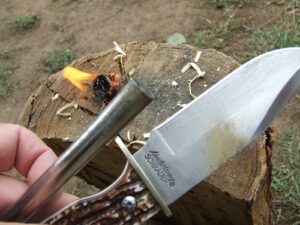
The Uncle Henry Next Generation Bowie specs.
Total length – 9.375” (24 cm.)
Blade length – 5” (12.5 cm.)
Blade thickness – 1/8″ (3.175 mm.)
Steel – 7Cr17MovSteel Stainless Steel Blade
Design – Full tang, clip point, Bowie style blade with hollow grind.
Handle – Tapered butt with guard and Staglon scales.
Sheath – Leather with pouch.
Weight with knife, sheath and sharpening stone – 10.61 oz. (301 grams.)
Made in China.
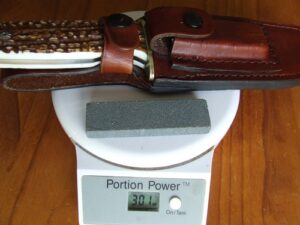
The field test and Bowie knife review.
Fire lighting with the ferro rod.
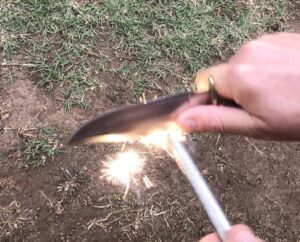
I like to check the back of the knife or spine, to see if it works well with a ferrocerium rod. Some knives like the Mora Garberg are even designed with the bushcrafter in mind, as the spine is designed with a 90 degree edge that creates sparks easily when scraped with a ferro rod.
To test it out, I held the knife stationary and drew the 6 inch ferro rod across it. The sparks it created were good. It wasn’t the best striker / scraper, but it worked well enough to through some decent sparks. Campfire here we come!
I will probably take a file to the spine to make it square and a little bit better scraper. But as is, the spine is okay with a ferrocerium rod.
(Just on a note on filing the spine, I don’t file the whole back of the spine. As sometimes I like to choke up on the handle and put my thumb on the blade. If the spine is filed, where you put your thumb it can be too rough. It is better to leave an inch or so untouched so it is comfortable for your thumb on the spine.)
Feather sticks.
The thin blade edge made carving feather sticks easier enough on some pine wood. The bit of wood used had an uneven grain and a few knots in it, so it wasn’t ideal for the test.
Batoning with the knife.
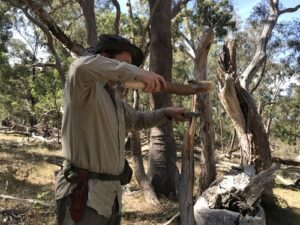
I know batoning is not for everyone and a lot of bushcrafters and survivalists disagree with it. But it does test to see how the knife, handle and blade hold up with some tough love.
While it is full tang knife and a thick enough blade, I wasn’t sure how the Staglon handle scales would go with a bit of batoning.
Also the blade profile is hollow ground and has a thinner edge, so it isn’t the knife to go all in and baton with it. However, I do like putting the knives through the field test, and batoning them is one test for the review.
The Uncle Henry Next Generation Bowie done well in the test for it’s steel.
Chopping with the bowie knife.
Obviously a bit small for some larger knife chopping, but because of its weight and wider blade design, the knife done okay on some smaller sticks and branches. It would struggle as a chopper.
The hollow ground edge also doesn’t split wood well, (As to be expected for its size and design.) as it bites in, but it does seem balanced well.
Processing game with the knife.
I used it for dressing one fish, a small rainbow trout that I caught and it was fine to use. (I would have liked to say, I used the knife on plenty of huge trout and bass that I caught, but it wasn’t the case.)
Unfortunately the closest it got to processing big game, was cutting up some old venison in the freezer to make some homemade venison jerky. Yum! The Bowie done well and cutting the meat into strips was fine.
Sharpening the knife, edge retention and the 7Cr17MovSteel.
The 7Cr17MovSteel is apparently a lower grade steel, but reasonable. It helps edge retention and is soft enough to supposedly sharpen easy.
I was a little bit apprehensive that the knife with a bit of use, would not hold its edge.
After plenty of use and some woodcraft, the edge was understandably in need of some TLC (Tender loving care. Not the 90s girl band.)
It did take a bit to sharpen the knife on the wetstone. (Whetstone.) With a bit of effort the edge come up sharp.
Overall I thought the steel was decent for the value and price.
The Uncle Henry Next Generation Bowie handle.
After a lot of work with it, the handle felt fine and with no rough hotspots. The scales I initially mentioned on the handle that had a bumpy edge, did not rub.
I disliked the tapered butt as I couldn’t get a real solid grip on it.
The Staglon scales are fixed by two star hex rivets, which suited the design.
One drawback of the handle was, the top and bottom of the scales and tang was a bit smooth with no grip.
If you gripped or held the knife on the side, the Staglon scales had plenty of grip and was firm to hold. However, if you partially grip just the top and bottom of it and not the sides, it wasn’t a solid grip and could be slippery. The tapered butt, made it less solid to hold as well.
The handle had a lanyard hole. (I didn’t use a lanyard on it.)
The hand guard.
I really do like the hand guard or Quillon.
I know that you should always be careful with a knife, but with slippery hands, it is easy to slip from the handle to the blade without a guard. Especially if your hands are wet, hot, cold, or have slime from fishing. So the guard is reassuring and also looks nice.
I like to choke up on the knife and blade for some woodcraft, the guard didn’t really get in the way. Well it did for a start, but then I got used to it and it was fine.
The Uncle Henry Bowie sheath.
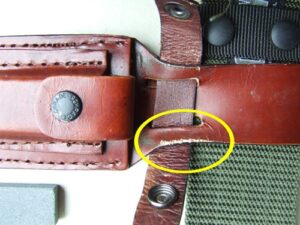
The sheath held up well with plenty of use getting the knife in and out.
It did have some wear close to where you insert the knife into the sheath and close to the retaining strap.
The belt loop was wide enough for a normal belt around two inches. It did fit my military webbing belt that is around 2 ¼ inches wide.
Overall the sheath is solid construction and looks nice. The color matches well with the knife handle.
The press stud retaining strap held the knife securely in the sheath. Initially it was a bit hard to secure the press stud, but with use become easier.
The sharpening stone supplied in the pouch
Initially I was going to replace the stone in the sheath pouch and put a fire lighting tool there. Like a small ferro rod. Then I thought it is handy having the stone on the sheath. Ideally it means no excuses for not maintaining the blade regularly. Having said that, the sharpening stone was a course grit.
The sharpening stone was a course grit on both sides. It would have been nice to have a fine grit side and a course grit on the other side.
For the field, the stone supplied would do in a pinch, but it didn’t seem a top of the line wetstone.
I have used the stone and just put a little bit of spittle (The nicer way of saying spit.) on the stone.
To get the stone out of front pouch on the sheath, the knife has to be out of the sheath. Which is fine, because you are going to take the knife out of the sheath to sharpen it anyway.
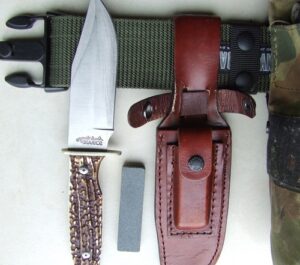
Summary – Uncle Henry Next Generation Staglon Bowie Review.
Overall I am impressed with this little knife. I say little, but it is more of a medium knife being at over 9” inches long. I think compared to a big bowie knife it looks and feels small.
If they had not tapered the handle down at the butt, but left it square, the handle size would have been better and fitted more hand sizes. It would have made the grip more solid and secure.
The knife isn’t designed as a bushcraft and survival knife, as it is more limited doing a lot of woodcraft with it. As the hollow grind is more designed for general field use and processing game, not woodcraft.
If you understand the hollow grind blade limitations and work with that, then it is a good belt knife to use for camping, fishing or hunting.
For the price of it, the little Bowie it is a great value camping knife.
Additional resources and information.
Best Bushcraft Knives Under $100.
